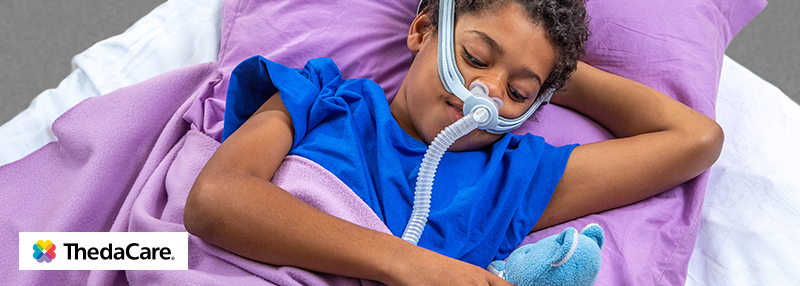
Starting CPAP therapy can be a big adjustment, especially for kids. Whether your child has been diagnosed with pediatric obstructive sleep apnea (OSA) or another condition requiring CPAP, the initial transition may come with some resistance, discomfort, or uncertainty. As a parent or caregiver, your encouragement and support play a vital role in helping your child build healthy, lifelong sleep habits.
With patience, the right approach, and comfortable equipment from ThedaCare At Home, CPAP therapy can become a routine part of bedtime that leads to better rest and better health.
Why CPAP Therapy Matters for Children
Pediatric sleep apnea affects a child’s breathing during sleep and can lead to:
- Daytime fatigue and poor focus
- Behavioral challenges
- Growth and development concerns
- Increased risk of cardiovascular issues over time
CPAP (Continuous Positive Airway Pressure) therapy helps keep the airway open during sleep, preventing interruptions in breathing and allowing for more restful, restorative sleep.
7 Tips to Help Your Child Adjust to CPAP Therapy
Every child is different, but these proven strategies can help your little one feel more comfortable and in control:
1. Involve Your Child in the Process
Give your child age-appropriate choices to help them feel empowered. Let them:
- Pick out a mask style or headgear color
- Name their CPAP machine (some families decorate it with stickers!)
- Help set up the machine as part of a nightly “sleep ritual”
Related: How Does a CPAP Machine Work to Treat Sleep Apnea?
2. Start Slow
Begin with short, low-pressure sessions during the day, like wearing the mask while watching a favorite show or reading. This helps build comfort and familiarity before bedtime.
3. Make It Routine (and Predictable)
Children thrive on consistency. Incorporate CPAP setup into their nightly routine, just like brushing teeth or reading a story. Consider using a visual schedule if your child responds well to structure.
Related: Better Sleep with Sleep Apnea: 6 Tips for a Restful Night
4. Use Positive Reinforcement
Celebrate small milestones, like wearing the mask for 30 minutes or a full night. Try:
- Sticker charts
- Verbal praise
- Small incentives for progress
5. Ensure a Comfortable Fit
If your child complains about discomfort, don’t give up. Mask fit is key! Consider trying a different size or style. Some kids prefer nasal pillows, while others do better with a nasal mask or minimal headgear.
Related: Tips for Adjusting to CPAP Therapy: Overcoming Challenges as a New User
6. Address Sensory Sensitivities
Children with sensory processing differences (common in kids with ADHD or autism) may need extra support. Try:
- Desensitization techniques (touching, holding, then wearing the mask gradually)
- CPAP-friendly stuffed animals or pillows for comfort
- Allowing the machine to run while the child listens to it before bedtime
7. Practice Good Sleep Hygiene
Create a relaxing bedtime environment to make sleep easier:
- Dim the lights an hour before bed
- Limit screen time
- Use white noise if helpful
- Keep bedtime consistent—even on weekends
CPAP Equipment That Supports Pediatric Comfort
ThedaCare At Home offers high-quality CPAP products trusted by families and sleep professionals. These tools make therapy more comfortable and less intimidating for children:
CPAP Machines
- AirSense™ 10 CPAP with HumidAir™ and ClimateLineAir™ Tube – A quiet, user-friendly machine with built-in humidification to reduce dryness and irritation.
- AirSense™ 11 AutoSet CPAP Elite – Offers advanced comfort features and digital support tools to help track therapy progress.
CPAP Masks
- ResMed AirFit™ N20 Nasal Mask – A compact, flexible mask that’s ideal for smaller faces.
- ResMed AirFit™ P10 Nasal Pillows Mask – Lightweight and minimal, great for kids who feel claustrophobic in larger masks.
- Fisher & Paykel Brevida™ Nasal Mask – Designed for comfort and ease of use, with soft nasal pillows and adjustable headgear.
Helpful Accessories for Better Sleep
- CPAP Mask Wipes – Make daily cleaning quick and easy.
- Contour CPAP Pillow – Made for side sleepers wearing masks and can help your child sleep more comfortably.
- Humidifiers & Tubing – Reduce airway irritation and improve your child’s comfort.
Browse Pediatric-Friendly CPAP Products
Related: Comprehensive Guide to Cleaning and Maintaining Your CPAP Machine
When to Contact Your Provider
Call your child’s doctor, sleep specialist, or ThedaCare At Home team if:
- The mask is causing irritation or leaks
- Your child refuses to wear it after consistent attempts
- You’re unsure about fit, pressure settings, or machine usage
ThedaCare At Home offers support for equipment education, proper fit, and ongoing care.
Our CPAP Team Is Here for You & Your Family
Starting CPAP therapy isn’t always easy, but with the right approach and support, your child can adjust and thrive. Over time, many children report feeling more rested and alert, and parents often notice improvements in mood, focus, and growth.
If you’re unsure where to begin or need help finding the best pediatric equipment, ThedaCare At Home is here to help. Our team provides compassionate, local support and trusted brands that prioritize comfort, safety, and results.
August 27, 2025 by ThedaCare At Home

